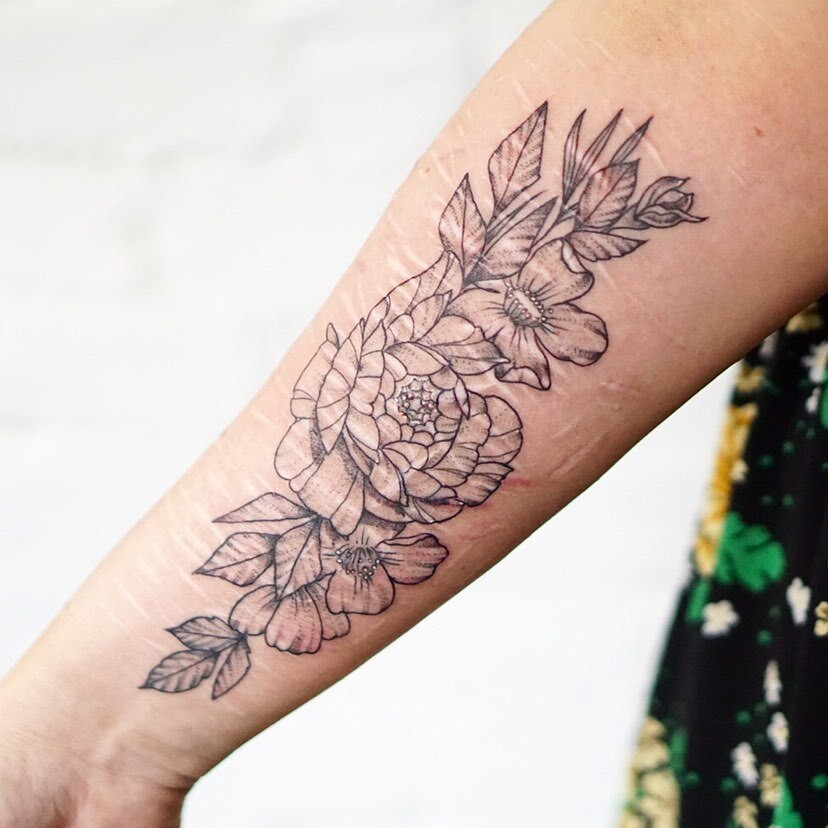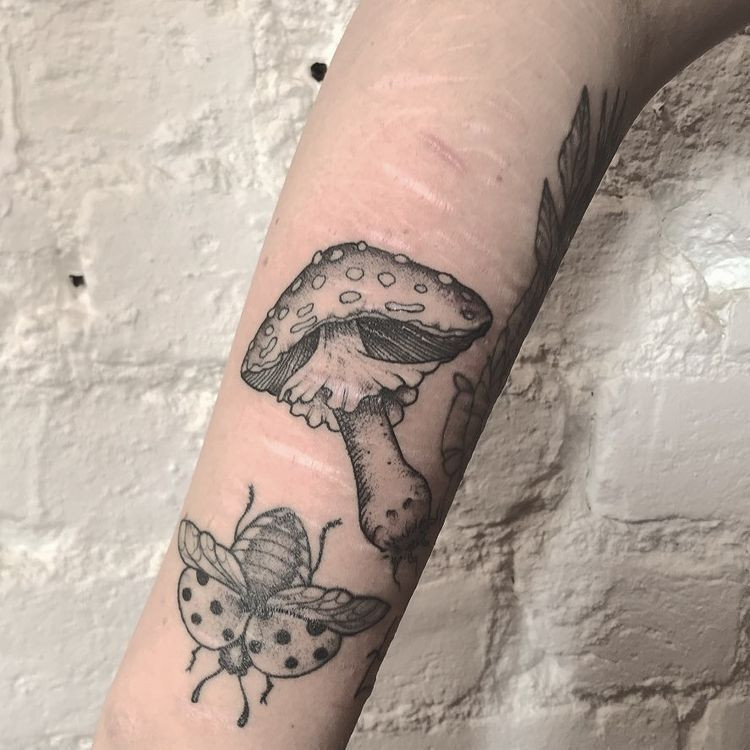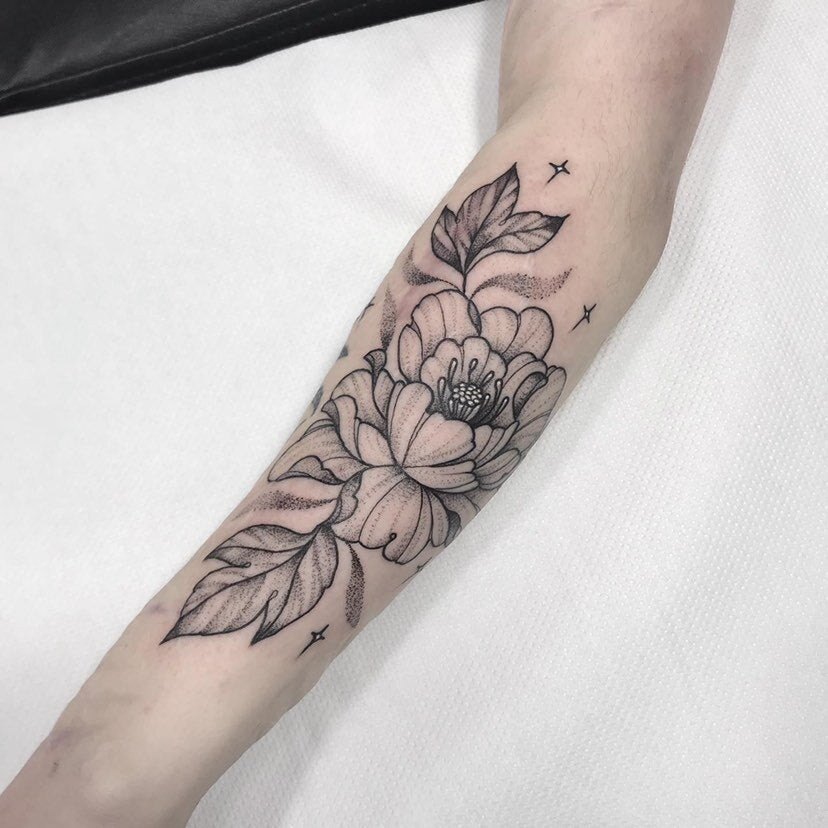Can You Tattoo Over Pink Scars? Yes, you can tattoo over pink scars, but it’s essential to understand the process, potential challenges, and how to ensure the best possible results, and tattooat.com is here to guide you through every step with expert advice and stunning design ideas. With proper preparation, aftercare, and guidance from a skilled tattoo artist, you can transform scars into beautiful works of art, enhance your body image, and boost your confidence. Explore tattoo cover-ups, medical tattooing, and scar camouflage at tattooat.com.
1. Understanding Pink Scars and Tattooing
Pink scars are a common type of scar that results from the natural healing process of the skin after an injury, surgery, or trauma. These scars are typically characterized by their pink or reddish hue, which is due to increased blood flow and the formation of new blood vessels in the scar tissue. Tattooing over pink scars requires careful consideration due to the unique characteristics of scar tissue compared to healthy skin.
1.1 What Are Pink Scars?
Pink scars are immature scars that are still in the early stages of healing. They appear pink because of increased vascularity as the body attempts to repair the damaged tissue. Over time, most pink scars will fade to a lighter color, but this process can take months or even years, depending on the individual and the severity of the scar.
1.2 How Do Pink Scars Differ From Other Types of Scars?
Pink scars differ from other types of scars in several key ways:
- Color: Pink scars are distinctly pink or red, while other scars may be white, brown, or even raised and keloid.
- Age: Pink scars are relatively new, whereas other scars may be older and fully healed.
- Sensitivity: Pink scars are often more sensitive to the touch than older scars due to the presence of new blood vessels and nerve endings.
- Texture: Pink scars may have a smoother texture compared to mature scars, which can be thicker and more rigid.
1.3 Why Tattooing Over Scars Is Different
Tattooing over scar tissue presents unique challenges compared to tattooing over healthy skin:
- Inconsistent Texture: Scar tissue has a different texture than normal skin, which can affect how the ink is absorbed and distributed.
- Sensitivity: Scars can be more sensitive, leading to increased pain during the tattooing process.
- Ink Retention: Scar tissue may not hold ink as well as healthy skin, requiring more frequent touch-ups.
- Appearance: The final tattoo may look different on scar tissue due to variations in skin tone and texture.
2. Key Considerations Before Tattooing Over Pink Scars
Before considering a tattoo over a pink scar, it’s crucial to evaluate several factors to ensure a successful outcome.
2.1 Scar Maturity and Healing Time
One of the most important considerations is the maturity and healing time of the scar. Tattooing over a scar that is still actively healing can lead to complications, such as infection, poor ink retention, and further damage to the tissue. Generally, it’s recommended to wait at least one to two years after the initial injury before tattooing over a scar. According to research from Portland State University’s Art Department, in July 2025, scars need at least a year to fully heal.
2.2 Scar Type and Severity
The type and severity of the scar also play a significant role in determining the feasibility of tattooing. Different types of scars, such as keloid scars, hypertrophic scars, and atrophic scars, have varying characteristics that can affect the tattooing process.
- Keloid Scars: These are raised scars that grow beyond the boundaries of the original wound. Tattooing over keloid scars is generally not recommended due to the risk of further irritation and growth.
- Hypertrophic Scars: Similar to keloid scars, hypertrophic scars are raised but remain within the boundaries of the original wound. Tattooing may be possible, but careful consideration and technique are required.
- Atrophic Scars: These are sunken or pitted scars, often caused by acne or chickenpox. Tattooing can be effective in camouflaging atrophic scars, but the artist must be skilled in working with uneven skin textures.
 Tattoo by Justin West (@sailors_rehab)
Tattoo by Justin West (@sailors_rehab)
2.3 Pain Tolerance and Sensitivity
Scar tissue can be more sensitive than normal skin, so it’s essential to consider your pain tolerance before undergoing a tattoo procedure. Some people may experience increased pain and discomfort when tattooed over scars, while others may find it manageable.
2.4 Skin Tone and Pigmentation
Skin tone and pigmentation can affect how the tattoo ink appears on the scar tissue. Scars may have different pigmentation than the surrounding skin, which can impact the overall look of the tattoo. A skilled artist can work with these variations to create a cohesive and visually appealing design.
2.5 Allergies and Skin Conditions
It’s crucial to inform your tattoo artist about any allergies or skin conditions you may have, as these can affect the healing process and the choice of tattoo ink. People with sensitive skin or allergies may be more prone to adverse reactions to tattoo pigments.
3. Finding the Right Tattoo Artist
Choosing an experienced and skilled tattoo artist is paramount when considering a tattoo over a pink scar. Not all artists are comfortable or experienced in working with scar tissue, so it’s essential to do your research and find someone who specializes in this area.
3.1 Importance of Experience and Expertise
An experienced tattoo artist will have a thorough understanding of scar tissue and how it reacts to tattooing. They will be able to assess the scar, recommend appropriate designs, and use techniques that minimize pain and maximize ink retention.
3.2 Portfolio Review and Consultation
Before committing to a tattoo artist, review their portfolio to see examples of their work on scars. Look for tattoos that are well-executed, with smooth lines, even color saturation, and minimal distortion. Schedule a consultation with the artist to discuss your goals, concerns, and any specific requirements you may have.
3.3 Questions to Ask Your Tattoo Artist
During the consultation, ask the artist the following questions:
- How many years of experience do you have tattooing over scars?
- Can you show me examples of your work on similar types of scars?
- What techniques do you use to minimize pain and maximize ink retention on scar tissue?
- What type of tattoo ink do you recommend for my skin tone and scar type?
- What is the expected healing time, and what aftercare instructions should I follow?
3.4 Red Flags to Watch Out For
Be wary of tattoo artists who:
- Are dismissive of your concerns or questions
- Guarantee perfect results without assessing the scar
- Lack experience or expertise in tattooing over scars
- Have a poor reputation or negative reviews
4. Design Ideas and Considerations
Choosing the right design is crucial for a successful tattoo over a pink scar. The design should complement the shape, size, and location of the scar, while also reflecting your personal style and preferences.
4.1 Incorporating the Scar Into the Design
One popular approach is to incorporate the scar into the design, turning it into a meaningful and beautiful part of the tattoo. This can be achieved by using the scar as a natural line or element within the design.
4.2 Cover-Up Tattoos
Cover-up tattoos are designed to completely conceal the scar with a new design. This requires careful planning and execution to ensure that the scar is fully covered and that the new design is visually appealing.
4.3 Camouflage Tattoos
Camouflage tattoos use skin-toned pigments to blend the scar with the surrounding skin. This technique is often used for scars that are lighter or darker than the natural skin tone.
4.4 Popular Design Themes
Some popular design themes for tattoos over scars include:
- Floral designs
- Geometric patterns
- Abstract art
- Nature-inspired motifs
- Tribal patterns
 Tattoo by Justin West (@sailors_rehab)
Tattoo by Justin West (@sailors_rehab)
4.5 Color vs. Black and Gray
The choice between color and black and gray ink depends on several factors, including skin tone, scar type, and personal preference. Black and gray tattoos tend to be more effective at concealing scars, while color tattoos can add vibrancy and visual interest.
5. The Tattooing Process: Step-by-Step
The tattooing process for pink scars is similar to that of regular tattoos, but with some important modifications to account for the unique characteristics of scar tissue.
5.1 Preparation and Numbing
Before the tattooing begins, the artist will clean and sterilize the area around the scar. A topical numbing cream may be applied to reduce pain and discomfort during the procedure.
5.2 Stenciling and Outlining
The tattoo design is transferred onto the skin using a stencil. The artist will then outline the design using a tattoo machine and appropriate needle configuration.
5.3 Shading and Coloring
Once the outline is complete, the artist will begin shading and coloring the tattoo. This process involves using different needle configurations and techniques to create depth, dimension, and visual interest.
5.4 Addressing Challenges Specific to Scar Tissue
Throughout the tattooing process, the artist will need to address challenges specific to scar tissue, such as inconsistent texture, sensitivity, and ink retention. This may involve adjusting the tattooing technique, using different needle depths, and applying additional pressure to ensure that the ink is properly absorbed.
6. Pain Management Techniques
Tattooing over pink scars can be more painful than tattooing over normal skin due to the increased sensitivity of scar tissue. Several pain management techniques can help to minimize discomfort during the procedure.
6.1 Topical Numbing Creams
Topical numbing creams containing lidocaine or tetracaine can be applied to the skin before the tattooing to reduce pain and sensitivity.
6.2 Cold Compresses
Applying cold compresses to the area during tattooing can help to numb the skin and reduce inflammation.
6.3 Breathing Exercises and Meditation
Deep breathing exercises and meditation can help to calm the mind and reduce anxiety, making the tattooing process more manageable.
6.4 Breaks and Communication
Taking frequent breaks during the tattooing process can help to alleviate pain and discomfort. It’s also important to communicate with your artist and let them know if you’re experiencing too much pain.
7. Aftercare Instructions for Tattooed Scars
Proper aftercare is crucial for ensuring that your tattooed scar heals properly and that the tattoo looks its best.
7.1 Cleaning and Moisturizing
Keep the tattooed area clean by gently washing it with mild soap and water. Apply a thin layer of fragrance-free moisturizer to keep the skin hydrated.
7.2 Avoiding Sun Exposure
Protect the tattooed area from sun exposure by wearing loose-fitting clothing or applying sunscreen with an SPF of 30 or higher.
7.3 Preventing Infection
Avoid touching or scratching the tattooed area to prevent infection. If you notice any signs of infection, such as redness, swelling, or pus, consult a doctor immediately.
7.4 Long-Term Maintenance
To keep your tattoo looking its best, moisturize regularly and avoid excessive sun exposure. Touch-ups may be necessary over time to maintain the vibrancy and clarity of the design.
8. Potential Risks and Complications
While tattooing over pink scars can be a safe and effective way to improve the appearance of scars, there are potential risks and complications to be aware of.
8.1 Infection
Infection is a risk with any tattoo, but it’s especially important to take precautions when tattooing over scar tissue, as scars can be more prone to infection.
8.2 Allergic Reactions
Allergic reactions to tattoo ink can occur, causing itching, redness, and swelling. It’s important to inform your artist about any allergies you may have and to choose hypoallergenic inks.
8.3 Keloid Formation
In rare cases, tattooing over scars can lead to the formation of keloid scars, which are raised and thickened scars that grow beyond the boundaries of the original wound.
8.4 Ink Fading and Distortion
Ink fading and distortion can occur over time, especially on scar tissue. Touch-ups may be necessary to maintain the appearance of the tattoo.
 Tattoo by Justin West (@sailors_rehab)
Tattoo by Justin West (@sailors_rehab)
8.5 Uneven Healing
Scar tissue can heal unevenly, which can affect the appearance of the tattoo. Proper aftercare and moisturizing can help to minimize this risk.
9. Medical Tattooing and Scar Camouflage
Medical tattooing and scar camouflage are specialized techniques that use tattoo ink to improve the appearance of scars and other skin conditions.
9.1 What Is Medical Tattooing?
Medical tattooing involves using tattoo ink to correct or camouflage skin imperfections, such as scars, burns, and vitiligo.
9.2 How Does Scar Camouflage Work?
Scar camouflage uses skin-toned pigments to blend the scar with the surrounding skin. This technique is often used for scars that are lighter or darker than the natural skin tone.
9.3 Benefits of Medical Tattooing
Medical tattooing can provide numerous benefits, including:
- Improved appearance of scars
- Increased self-confidence
- Reduced visibility of skin imperfections
- Long-lasting results
9.4 Finding a Qualified Medical Tattoo Artist
It’s important to find a qualified medical tattoo artist who has experience and expertise in scar camouflage. Look for an artist who is licensed, certified, and has a strong portfolio of before-and-after photos.
10. Success Stories and Inspiration
Many people have successfully tattooed over pink scars, transforming them into beautiful works of art and boosting their self-confidence.
10.1 Real-Life Examples of Tattooed Scars
- A woman with a surgical scar on her abdomen had it covered with a floral tattoo, turning it into a symbol of strength and resilience.
- A man with acne scars on his face had them camouflaged with skin-toned pigments, improving his complexion and self-esteem.
- A burn survivor had her scars incorporated into a nature-inspired tattoo, creating a unique and empowering piece of body art.
10.2 Positive Impact on Body Image and Self-Esteem
Tattooing over scars can have a profound impact on body image and self-esteem. By transforming scars into beautiful and meaningful designs, people can reclaim their bodies and feel more confident in their own skin.
10.3 Finding Inspiration and Ideas
Browse online tattoo galleries and social media platforms to find inspiration and ideas for your own tattoo over a pink scar. Consult with your tattoo artist to develop a design that is tailored to your specific needs and preferences.
FAQ: Tattooing Over Pink Scars
1. How long should I wait before tattooing over a pink scar?
Generally, wait at least one to two years after the initial injury to ensure the scar is fully healed.
2. Is tattooing over a scar more painful?
Yes, scar tissue can be more sensitive, potentially increasing pain during the tattooing process.
3. Can all types of scars be tattooed over?
No, keloid scars are generally not recommended for tattooing due to the risk of further irritation.
4. Will the tattoo ink look the same on scar tissue as on normal skin?
No, scar tissue may not hold ink as well, and the final tattoo may look different due to variations in skin tone and texture.
5. How do I find a tattoo artist experienced in tattooing over scars?
Review portfolios, ask for recommendations, and schedule consultations to assess their expertise.
6. What are some popular design ideas for tattoos over scars?
Floral designs, geometric patterns, and nature-inspired motifs are popular choices.
7. Is aftercare different for tattoos over scars?
Yes, proper cleaning, moisturizing, and sun protection are crucial for ensuring proper healing.
8. What are the potential risks of tattooing over scars?
Risks include infection, allergic reactions, keloid formation, and uneven healing.
9. What is medical tattooing, and how can it help with scars?
Medical tattooing uses tattoo ink to correct or camouflage skin imperfections, such as scars, improving their appearance.
10. Can tattooing over scars really improve body image and self-esteem?
Yes, transforming scars into meaningful designs can help people reclaim their bodies and feel more confident.
Ready to transform your pink scars into stunning works of art? Visit tattooat.com today for inspiration, expert advice, and a curated list of talented tattoo artists in the USA. Discover the perfect design, find a skilled artist near you, and learn everything you need to know about tattooing over scars. Explore the possibilities at tattooat.com and start your journey to a more confident and beautiful you!
Address: 1825 SW Broadway, Portland, OR 97201, United States
Phone: +1 (503) 725-3000
Website: tattooat.com